Cane and Bamboo Crafts of Manipur
- Part 11 -
By: Mutua Bahadur *
EFFIGIES AND IMAGES
Baskets woven in the pattern of diagonals filled in to the texture of the open hexagonal weave are represented as effigies of fowl in death rituals which the people in the hills conduct in the memory of their forefathers. One also sees such basket-effigies on the occasion of a 'Feast of Merit' to inaugurate a newly-built house, and also in rituals performed to drive away evil spirits. Some of the tribal groups put up effigies made of bamboo representing human skulls. These are placed on the verandah of the house. At Andro, in the case of a death, a miniaturised effigy of the dead is created with bamboo (Fig.92). The effigy is adorned with clothes and is put up by an elder of the village. This practice is still in vogue.
At the time of the Umanglai Haraoba (Festivities of the Sylvan Deities) the Meitei Priest (Maiba) and Priestess (Maibi) place brass masks, representing the Umanglais inside baskets made of bamboo splits (Fig.93). The baskets with brass masks are worshipped as images of the Deities. Cloth is draped around and below the masks to complete the image. On conclusion of the Haraoba, the masks and the clothes are removed from the basket, and the basket is 'safely' stored away inside the temple for use at the next Haraoba.

ARCHITECTURE In earlier times, people living in the Manipur valley commonly built their houses, cooking-huts, out-houses and granaries with bamboo and thatch since both the materials were available in abundance. Bamboo was readily and cheaply available since practically every household had enough bamboo growing on their land. Being an agricultural land, procuring thatch was no problem. Meitei houses are built facing the east.
The post-World War II era saw changes in the architecture of the Meitei houses. The bamboo supports and pillars began to be replaced by wooden ones. However, the Hoomdaang or lower roof support and the U-ra or upper roof support of houses with thatched roof survived the immediate changes and continued to be made with bamboo for some time.
Although all the bamboo pillars were replaced by wooden ones, one bamboo pillar has been retained in the South-Western corner of the house where a secluded space is reserved for worshipping the Sanamahi, the Meitei Household Deity. The lone bamboo pillar is referred to as the Utang-wa, and it is more or less a symbol of the vanishing Meitei architectural tradition of using bamboo pillars in the construction of houses.
There are more than a hundred names for the various pillars, supports, roof-supports, and a host of other parts necessary in the construction of a typical Meitei house. The Meitei house-builders set various rules for building houses, based on the condition of the bamboo, i.e., the usability or non-usability of the bamboo. This is done by examining the 'health' of the bamboo, by looking at the Wamit or 'eye' and Shadong or 'flesh' of the bamboo.
The walls of the houses are first constructed with Shinghoot (Phragmites) and then reinforced with bamboo splits tied across horizontally. The next step is to plaster the wall with a mixture of earth and straw chips. In the valley, before setting up the pillars in the construction of a typical Meitei house, a certain pillar known as Urep is set up first.
The other pillars are set up after this particular pillar has been positioned. The Meitei house-builder identifies two sections in the verandah of a house with the setting up of pillars at certain points along the verandah. The pillar on the right side of the verandah marks a section known as Phamen, and that on the left side of the verandah marks another section known as Naktha.
The Phamen is reserved as a resting place for the elders of the family, and the Naktha is specified as a place where the women make cloth (on loin-looms etc.), spin yam, etc. The pillars marking out the Phamen and the Naktha are to be set up in such a way that they should maintain specific distances as laid down in the Meitei architectural lore. The gap between the right end of the verandah and the pillar positioned on the Phamen is much wider than that maintained between the left end of the verandah and the pillar positioned on the Naktha.
Meitei architectural lore affirms that the wider gap maintained in the Phamen enhances fertility and thereby increases the number of people living in the house. The narrower gap maintained in the Naktha is said to reduce the number of deaths in the family. As a rule, the main door is usually placed a little to the left, not in the middle or to the right.
After setting up the pillars, long Loikhangs or lower horizontal support beams are placed over the pillars. The next step is to position the Hoomdaang. There are several customs related to the placing of Hoomdaang. When placing the Hoomdaang over the Loikhang, care is taken not to put the former in places which are directly in line with the pillars. It is considered inauspicious if a Hoomdaang is placed directly above the pillar.
However, this strict code is relaxed to allow a single Hoomdaang to be placed above a pillar which stands in the secluded area where the Sanamahi is worshipped. This is referred to as Hoomdaang Kokthong-naaba' (the literal meaning is: 'to bear the hoomdaang on the head'. There might be several opinions on the topic, but the 'Hoomdaang Kokthong-naaba' is nonetheless a symbol of sexual copulation - hence, symbolising the fertility concept.
From whichever side the placement of the Hoomdaang is begun, the rule is to end the process eventually in the corner of the roof, overlooking the left side of the verandah. The belief behind this practice is that the 'live souls' are placed first into the being of the house and that the 'dead souls' are placed last. When placing the Hoomdaang in the corner of the roof mentioned above, it is disallowed to put the bamboo with its 'eye' facing downwards.
The reason given is that on so doing, the 'dead souls' look down upon the household all the time. This becomes inauspicious for the family. Hence, care is always taken to put the bamboo with its 'eye' facing horizontally either to the right or to the left. Again, when placing U-ra above the Hoomdaang, the number of U-ra placed on the right side of the roof and those placed on the left side are made unequal. It is seen to it that the U-ra placed on the right side should be greater in number from those placed on the left side.
The philosophy behind this is that by doing so, a greater number of 'live souls' and a lesser number of 'dead souls' (represented respectively by the U-ras) are incorporated into the being of the house. After placing the U-ra, the next step is to cover the roof with thatch. A triangular structure made of bamboo splits is fixed above the front wall of the house but below the roof. It serves more or less as a ventilating outlet.
Flowers, birds, houses, etc. made of finely chiselled bamboo splits are placed among the interlacing weaves in the structure, thus decorating it to present a lovely ventilator, called Yengai (Fig.94). An interesting feature of the architecture is the practice of placing the Wa-makok (tip or apex of the bamboo) that are used as horizontal support beams and as roof support beams towards the front of the house i.e., towards the East. These bamboo are sort-of personified, in the sense that they are supposed to 'sleep' with their 'heads' or Wa-makok towards the front of the house just as the human beings (referring to the Meiteis) in the house are supposed to do.
The important feature of the architecture of a typical Meitei house is non-use of nails or any other metallic objects to secure or fasten the beams and the other supports. Cane and fine bamboo splits soaked in water are used for this purpose. To secure the beams and other supports firmly to each other, holes are drilled on the bamboo, and Pungjeis (sharp-pointed bamboo objects, about30 cm. in length) are driven home into the holes. A Pungjei functions like a modern nail. The tip of the bamboo pillars are cut just above the node so that it provides strength.
The people inhabiting the hilly regions of Manipur cut bamboo and wood from the hills to make their houses. The pillars, the horizontal support beams and the roof support beams are all of wood and bamboo. The upper roof supports are mostly of bamboo split. Thatch is used for covering the roof. The Chin-Kuki groups commonly build houses in the pile-dwelling style, which is normally referred to as Kangthak-haaba. Bamboo is extensively used for the Kangthak-haaba.
The houses have an extended verandah made of bamboo, and the platform for these extended verandah is improvised with mats made of bamboo. Temporary walls as well as permanent walls are constructed with bamboo-mats. The Naga groups living in the Tamenglong District build houses having roofs made of bamboo splits.
Big bamboo poles are vertically split into two, and the bamboo splits are arranged in alternative turns, i.e., the pieces faces up and down alternately. In some areas of Jiribam, the bamboo poles are cut into pieces. The cut pieces are then smashed. Starting from the fringe of the roof, rows of the smashed bamboo are laid out one upon another to cover the whole of the roof, in the same fashion as when thatch is laid out to cover the roof.



CARVING
The practice of carving varied ornamental patterns and different floral designs on the tip of bamboo implements which the women use when weaving clothes, is carried out by the local craftsmen. The floral designs carved on the bamboo implements are a form of the expressions of love from a lad (the craftsman) to a lass (the weaver). In many a case, a craftsman carves exquisite floral designs exlcusively for his beloved who finds pleasure on seeing the token of love, and feels proud of his skill. This naturally enhances the workmanship of the artisan.
The ornamental patterns are carved on the softer layer of the bamboo after the hard outer layer has been adequately skinned off. The patterns are first pencilled before doing the actual carving. Sometimes, a craftsman carves his own name after completing the decorative work. In the Meitei village of Kwatha, small bamboo tubes carved with beautiful designs, which are normally used as Paangugatem (Shuttle) for the looms, are presented as love tokens by the amorous youths to their beloveds (Fig. 96). The gifts are nonetheless utilised by the girls in actual work when weaving clothes. But, a girl never parts with the gift, regarding it as a precious token from her loved one.
A triangular structure of bamboo, having interlacing weaves done in the open weave style, is normally placed above the front wall but below the roof of a typical Meitei house. Replicas of birds, animals, flowers, etc. are carved out of fine bamboo splits that are quite thin but broad, and the carved items are fixed among the interlacing weaves of the structure. The carving is usually done with scissors and/or chisels.
The base Structure of such Conical Baskets as the Longkai, Inbow, etc. that are used by the Nungsai Chiru tribals, are carved with patterns which are formed when a red-hot iron is pressed hard on to the surface. Also appropriate holes are carved out on the base to enable it to be tied to the Basic Form with cane splits. The Base Structure for these Conical Baskets are made of vines obtained from the jungle. The vines easily tend to get spoiled by Stem Borers, so they are first treated to smoke for conditioning. After being smoked sufficiently, they are then used for making the Base Structures.
See a gallery photo of Cane and Bamboo Crafts of Manipur here.
To be continued ....
|
* Mutua Bahadur contributes to e-pao.net regularly. This article was webcasted on January 12, 2012.
* Comments posted by users in this discussion thread and other parts of this site are opinions of the individuals posting them (whose user ID is displayed alongside) and not the views of e-pao.net. We strongly recommend that users exercise responsibility, sensitivity and caution over language while writing your opinions which will be seen and read by other users. Please read a complete Guideline on using comments on this website.









